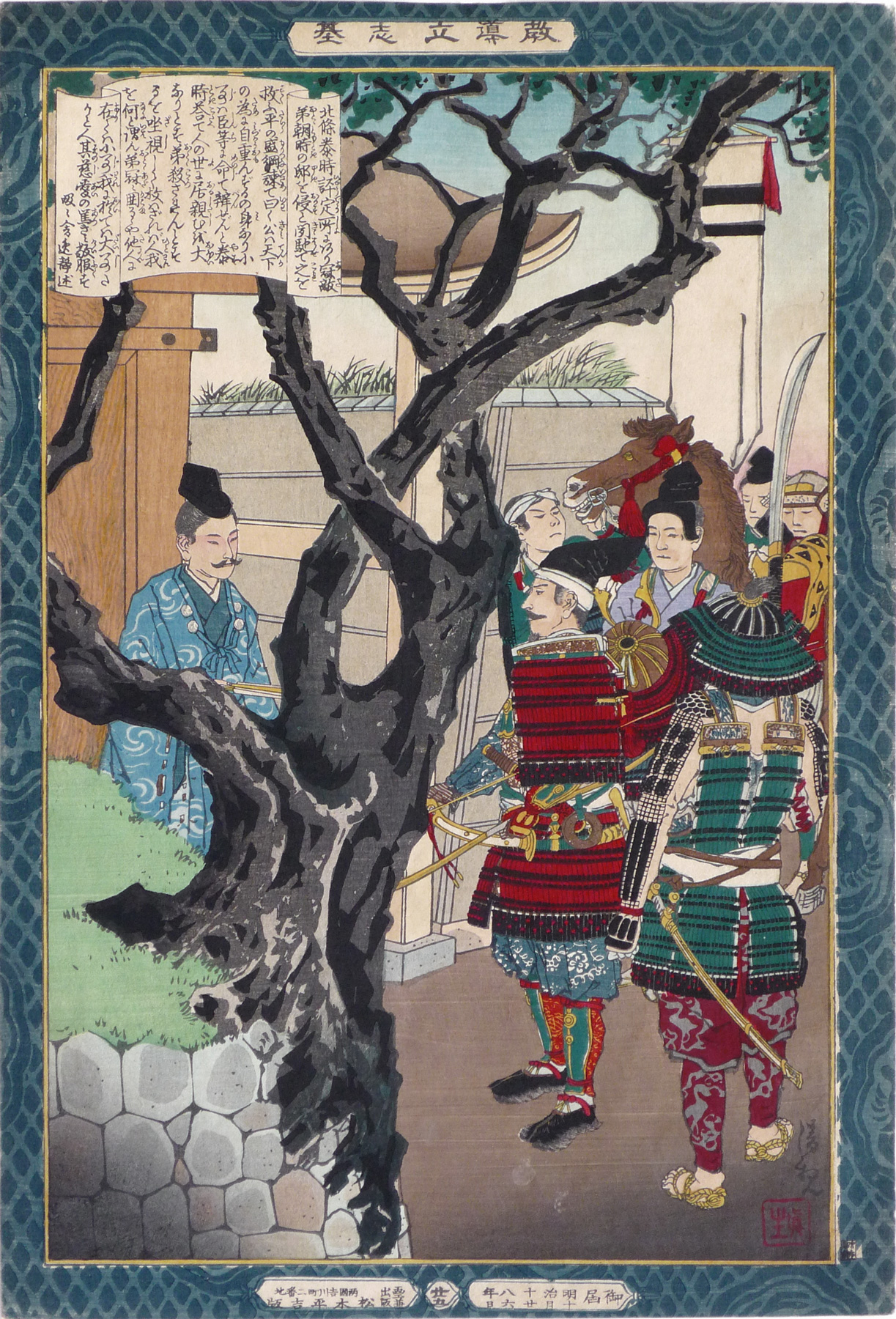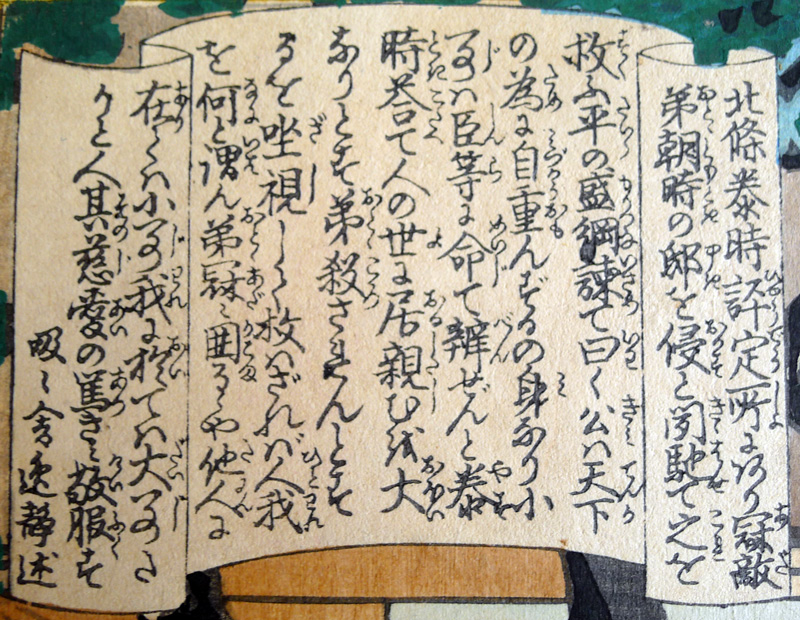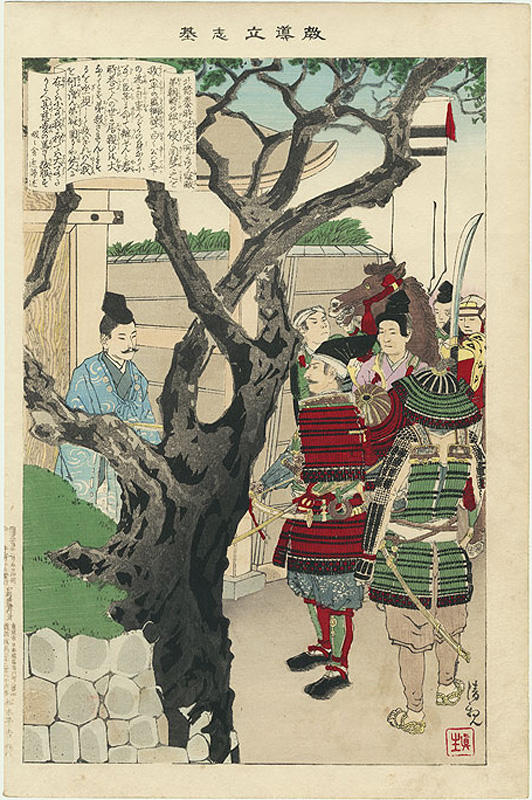About This Print
Two different states of print number 廿五 (25)1 in the series Instructive Models of Lofty Ambition picturing the armor-clad Hōjō Yasutoki 北条 泰時 (1183–1242), the third shikken (regent) of the Kamakura shogunate, being criticized by the seated Taira no Moritsuna 平の盛綱 for wasting his valuable time in coming to the aid of his younger brother Hōjō Tomotoki 北条 朝時 (1193-1245).Kiyochika contributed 20 prints to this series. As Smith states: "Thestyle of Kiyochika’s offerings to Instructive Models of LoftyAmbition was decorous and even stiff, as befitted the didacticemphasis of the whole [series.]"2
1 Numbering of the prints was haphazard during the production of the series. Print numbers were sometimes inadvertently omitted; some prints in the series were never assigned numbers and a few of the same numbers appear on different prints.
2 Kiyochika Artist of Meiji Japan, Henry D. Smith II, Santa Barbara Museum of Art, 1988, p. 74.
Hōjō Yasutoki Aiding His Younger Brother Tomotoki
Source: A History of the Japanese People - From the Earliest Times to the End of the Meiji Era, Frank Brinkley and Dairoku Kikuchi, The Encyclopædia Britannica Co., 1915, p. 348.One day, while attending a meeting of the Hyojoshu [Council of State], he received news that the house of his brother, Tomotoki, was attacked. Immediately he hastened to the rescue with a small band of followers. Subsequently, one of his principal retainers [Taira no Moritsuna - karei or "Governor of the Household"] remonstrated with him for risking his life in an affair so insignificant. Yasutoki answered: "How can you call an incident insignificant when my brother's safety was concerned? To me it seemed as important as the Shokyu struggle. If I had lost my brother, what consolation would my rank have furnished?"1
1 Another translation of this conversation goes: "This is but a small affair. My Lord holds an important office; why does he make light of himself?" Yasutoki replied: "How shall it be called a small affair when my brother is in danger? From my point of view, there is no difference between it and the wars of Kempo and Shokiu. Supposing I had to mourn for a relation, what were my high office to me?" (The Japan Weekly Mail, Vol. III, No. 1 January 6, 1872, "HISTORY OF THE HOJO FAMILY. A Fragment From The Nihon Guaishi Of Rai Santo.")
Transcription of Scroll
Source: with thanks to Yajifun http://yajifun.tumblr.com/click on scroll to enlarge
25 Hōjō Yasutoki 北條泰時教導立志基 廿五 北條泰時 小林清親 1885年10月26日
Transcription: [scroll text by 吸々舎逸静]
“北條泰時評定所にあり寇敵(あだ)弟朝時の邸を侵と?(聞 きゝ)馳て之を救ふ 平の盛綱諫て曰く 公ハ天下の為に自重(ミづからおも)んずるの身なり 小事ハ臣等に命て辨ぜん と 泰時答て 人の世に居親むを大なりとす 弟殺されんとするを坐視して救ハざれバ人我を何と謂ん 弟寇ニ囲るゝや他人に在てハ小事 我に於てハ大事たり と 人其慈愛の篤きに敬服す 吸々舎逸静 述”
Variant Edition and Later Reissue with White Border
| | 1902 reprint |
About The Series "Kyōdō risshi no motoi"
Notes:1. This series is variously translated as "Instructive Models of Lofty Ambition," "Foundations of Learning and Achievement," "Foundation of Instruction and Perseverance," "Self-Made Men Worthy of Emulation," "Paragons of Instruction and Success," "Moral of Success," "Examples of Self-Made Leaders," and "Instruction in the Fundamentals of Success." The title in Japanese is sometimes seen as "Kyōdō risshiki or "Kyōdō risshi no moto," in addition to the most commonly seen transliteration of "Kyōdō risshi no motoi".
2. For a complete listing of all the prints in the series and additional information please see the article on this site titled Instructive Models of Lofty Ambition.
This series ran between October 1885 and November 1890 and featured a long list of heroes and heroines, from antiquity to contemporary times, who were regarded as standards of moral leadership and self-realization.
Source: Kiyochika Artist of Meiji Japan, Henry D. Smith II, Santa Barbara Museum of Art, 1988, p. 74-75; original research and as footnoted.
This series of 58 prints,1 plus a table of contents sheet (目録), were originally published between October 1885 and November 1890 by the Tokyo publisher Matsuki Heikichi 松木平吉.2 The table of contents sheet issued by the publisher states that "fifty prints make up the complete set (五十番揃)". Three prints not in the initial release were added over the five year publication period, as were five redesigns of original prints, eventually increasing the total print count to 58. The seven artists contributing prints were Kobayashi Kiyochika (1847-1915) [20 prints], Mizuno Toshikata (1866-1908) [16 prints], Inoue Tankei (Yasuji) (1864-1889) [13 prints], Taiso (Tsukioka) Yoshitoshi (1839-1892) [5 prints], Yōshū Chikanobu (1838-1912) [2 prints], Toyohara Kunichika (1835–1900) [1 print], and Hachisuka (Utagawa) Kuniaki II (1835-1888) [1 print]. All the artists, with the exception of Yōshū Chikanobu, are listed in the top scroll of the table of contents sheet. Various colors (including blue, blue/green, and tan/brown) were used for the decorative border, and in 1902 the series was re-issued by Matsuki without borders.
This series of 58 prints,1 plus a table of contents sheet (目録), were originally published between October 1885 and November 1890 by the Tokyo publisher Matsuki Heikichi 松木平吉.2 The table of contents sheet issued by the publisher states that "fifty prints make up the complete set (五十番揃)". Three prints not in the initial release were added over the five year publication period, as were five redesigns of original prints, eventually increasing the total print count to 58. The seven artists contributing prints were Kobayashi Kiyochika (1847-1915) [20 prints], Mizuno Toshikata (1866-1908) [16 prints], Inoue Tankei (Yasuji) (1864-1889) [13 prints], Taiso (Tsukioka) Yoshitoshi (1839-1892) [5 prints], Yōshū Chikanobu (1838-1912) [2 prints], Toyohara Kunichika (1835–1900) [1 print], and Hachisuka (Utagawa) Kuniaki II (1835-1888) [1 print]. All the artists, with the exception of Yōshū Chikanobu, are listed in the top scroll of the table of contents sheet. Various colors (including blue, blue/green, and tan/brown) were used for the decorative border, and in 1902 the series was re-issued by Matsuki without borders.
Brief texts contained within a scroll-like cartouche appearing on each print provide historical details. The scroll composer's name is given at the end of the scroll text. The “lofty ambition” of the title is a Confucian concept, originally from Mencius, meaning “righteous determination that would inspire others.” The market for the series probably included former samurai, ambitious youth, and conservative intellectuals.
"[W]hen it was completed in 1890 the publisher was singled out for special recognition by the government for having sponsored such noble subject matter."3
1 The Tokyo Metropolitan Library online collection shows 50 prints and a Table of Contents sheet. The Table of Contents lists the titles of 50 prints. Smith in Kiyochika Artist of Meiji Japan identified 52 prints. I have identified 58 prints from this series including five prints (Ikina, Michizane Sugiwara, Kesa Gozen, Soga Brothers and Hokiichi Hanawa) that were re-designed and re-printed, likely due to damaged or lost blocks.
2 Robert Schaap notes in Appendix II, p. 166 of Yoshitoshi, Masterpieces from the Ed Freis Collection, Chris Uhlenbeck and Amy Reigle Newland, Hotei Publishing, 2011 that the series originally appeared as newspaper supplements.
3 The World of the Meiji Print: Impressions of a New Civilization, Julia Meech-Pekarik, Weatherhill, 1986, p. 122.
One of Five Prints from The Lavenberg Collection
loaned to the Portland Art Museum for the exhibition
"Legendary Samurai" September 14, 2013 to January 12, 2014
小林清親画 教導立志基・北条泰時
Kobayashi Kiyochika
(Japanese, 1847–1915)
Hōjō Yasutoki
From Instructive Models of Lofty Ambition
1885
Color woodblock print
Lent by The Lavenberg Collection of Japanese Prints
Hōjō Yasutoki (1183–1242) served as regent for the Kamakura shogunate, the first of three military regimes in Japan. In this scene, he has just returned from aiding his younger brother Tomotoki, whose home had come under attack. He stands before Taira Moritsuna, his advisor, who chastises him for risking his life over such a trifling matter, now that he is the most powerful official in the land. Yasutoki responds: “How shall it be called a small affair when my brother is in danger? ... If I had lost my brother, what consolation would my rank have furnished?"
Devotion to family over personal glory is only one of the reasons Yasutoki is judged by history as a paragon of warrior leadership. He is best known as the author of Goseibai shikimoku, a legal code that was remarkably ahead of its time.
Print Details
| IHL Catalog | #611, #1325 | ||
| Title or Description | Hōjō Yasutoki 北條泰時 | ||
| Series | “Instructive Models of Lofty Ambition” (Kyodo risshiki 教導立志基) [note: seriestitle also listed as 'Kyodo Risshi no Moto', ‘Kyodo risshi no motoi’,‘Kyōdō risshi ki’ and variously translated as “Moral of success” or“Foundations of learning and achievement” or “Self-made Men Worthy ofEmulation”' or “Examples of Self-made Leaders” or "Paragons of instruction and success"] | ||
| Artist | Kiyochika Kobayashi (1847-1915) | ||
| Signature | Kiyochika 清親 | ||
| Seal |  | ||
| Publication Date | October 26, 1885 明治十八年 十月廿六日 | ||
| Publisher | Matsuki Heikichi (松木平吉) proprietor of Daikokuya Heikichi [Marks: seal not shown; pub. ref. 029] IHL Cat. #611 click on image to enlarge (from right to left) publishing and printing date: 御届 明治十八年 十月廿六日 [notification delivered, Meiji 18th year 10th month 26th day] assigned number within series: 廿五 [25] publisher information: 画工兼 出版 両国吉川町二番地 松木平吉 版 [artist and publisher Ryōgoku Yoshikawachō 2-banchi Matsuki Heikichi han] | ||
| Carver |
| ||
| Impression | IHL Cat. #611 and IHL Cat. #1325: excellent | ||
| Colors | IHL Cat. #611 and IHL Cat. #1325: excellent | ||
| Condition | IHL Cat. #611: good - Japanese album backing paper; very minor marks and flaws IHL Cat. #1325 good - not backed; very minor marks and flaws | ||
| Genre | ukiyo-e; rishki-e; kyōiku nishiki-e | ||
| Miscellaneous | print number 25 (廿五); position 20 in the Table of Contents for the series; the print number 25 (廿五) also appears on the print tiled Takemitsu Kikuchi. IHL Cat. #611 was on previous loan to the Portland Art Museum loan number L2013.80.1 | ||
| Format | vertical oban | ||
| H x W Paper | IHL Cat. #611: 13 3/4 x 9 1/4 in. (34.9 x 23.5 cm) IHL Cat. #1325: 13 5/8 x 9 1/8 in. (34.6 x 23.2 cm) | ||
| H x W Image | IHL Cat. #611: 12 3/8 x 8 3/16 in. (31.4 x 20.8 cm) area inside brocade border IHL Cat. #1325: 12 3/8 x 8 1/8 in. (31.4 x 20.6 cm) area inside brocade border | ||
| Literature | | ||
| Collections This Print | British Museum 1989,0808,0.2; Tokyo Metropolitan Library 280-K034; Smithsonian Institution Freer Sackler S1995.116.3; Tsubouchi Memorial Theatre Museum of Waseda University 401-0563 |
9/24/2020







 IHL Cat #611
IHL Cat #611